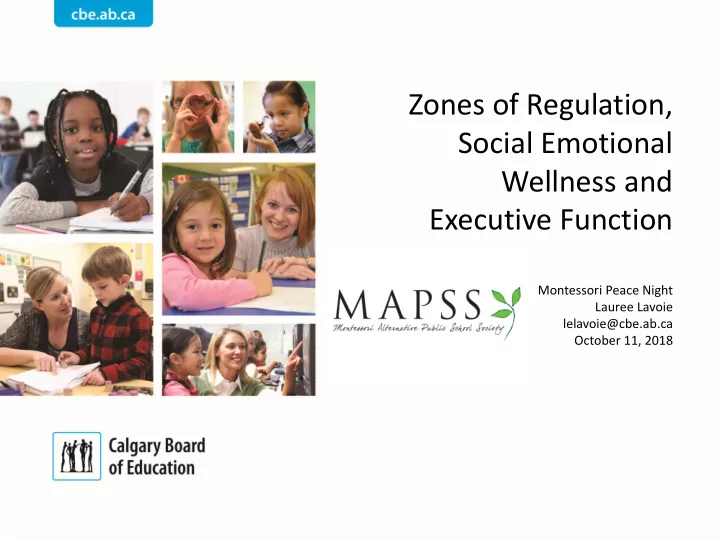

Zones of Regulation, Social Emotional Wellness and Executive Function Montessori Peace Night Lauree Lavoie lelavoie@cbe.ab.ca October 11, 2018
Welcome Introductions
Executive Functions • “The executive functions are a set of processes that all have to do with managing oneself and one's resources in order to achieve a goal. It is an umbrella term for the neurologically-based skills involving mental control and self- regulation.” (http://www.ldonline.org/article/29122/) • It is like an Air Traffic controller or a conductor of a symphony.
Executive Functions • The executive functions all serve a "command and control" function; they can be viewed as the "conductor" of all cognitive skills. • Executive functions help you manage life tasks of all types. For example, executive functions let you organize a trip, a research project, or a paper for school
Executive Function
Pre-Frontal Cortex New research is showing that E.F. is a whole brain activity involving the PFC and the Limbic System: emotional brain
How does our E.F. impact us on a daily basis? • At any given moment as adults we need to be able to make decisions, filter distractions in our environment, prioritize tasks that need to get finished, set and work towards achieving goals, and we need to control impulses. • 40,000-80,000 • Children also need to do the above many times throughout their day. • http://www.albertafamilywellness.org/reso urces/video/executive-function
Social Wellness • Social Competence can be defined as the capacity to initiate and maintain satisfying relationships with peers, as well as to be able to form friendships with some of them (Katz and McClellan, 1997) • The capacity to get along with peers is the best single predictor of adult adaptation, not IQ, not grades or classroom behaviour (Hartup, 1992) • The adequacy with which the children get along with others. • Social competence goes hand in hand with the ability to empathize with others.
Emotional Wellness • Emotional Competence is usually defined as awareness of one’s own and other’s feelings, the capacity to empathize with others, to distinguish between inner feelings and the outward expression of them, and awareness of the place of emotions in relationships (Saarni, 1999) • Having words to identify with their emotions
CASEL:Collaborative for Academic, Social, Emotional Learning
Framework • Self-management - The ability to successfully regulate one’s emotions, thoughts, and behaviors in different situations. • Self-awareness - The ability to accurately recognize one’s own emotions and thoughts and how these influence behavior. • Social awareness - The ability to take the perspective of and empathize with others, including those from diverse backgrounds and cultures. • Relationship skills • The ability to establish and maintain healthy and rewarding relationships with diverse individuals and groups. • Responsible decision-making -The ability to make constructive choices about personal behavior and social interactions based on ethical standards, safety concerns, and social norms.
Triggers: • Deerfoot Traffic scenario • Doctor Appt. scenario • Playground scenario https://www.youtube.com/watch?v= mtRrxNTnyh8 1. PFC 2. Amygdala 3. Hippocampus
Programs and Tools for Self Regulation A Framework to foster Self-Regulation and Emotional Control Created by Leah Kuypers
Framework • “Zones” gives the students the framework, language and lessons to become more aware and manage their emotions. • ”LIFE IS 10% WHAT HAPPENS TO US AND 90% HOW WE REACT TO IT.” - Charles Swindoll • Building the language to help children be able to identify their emotions and ultimately respond rather than react.
Building Awareness • When we can recognize when we are becoming less regulated, then we are able to do something about it. We can begin to learn how to manage our feelings and get ourselves to a healthy place. While this may come inherently natural for some, for others, it is a skill that needs to be explicitly taught and repeatedly practiced. • “Thinking Brain PFC, Alarm Brain – Amygdala” • Hippocampus
Blue, Green, Yellow and Red Zones
Tools – How can we help children be the very best they can be. • A consistent bedtime (ages 6-13 years need 10-13 hours of sleep, 14-17 years need 8-10 hours of sleep) • A healthy breakfast, snack and lunch – avoid excessive sugars • Be patient and provide lots of support • Model kindness • Praise effort consistently and not just outcome, celebrate successes • Consistent Language, acknowledgement of feelings, “expected vs unexpected behaviours” • Movement/Body Breaks – intentional and purposeful • “Peace Area” in classrooms and homes – a place where students can go to be reflective, an area to re-regulate, calm down – Stones, sand, books, mindful breathing jars, “Buddha boards”, choice seating, low lighting, rain makers, fidget tools
Tools continued • Wiggle seats • Hokki Stools • Preferential Seating • Stand – up desks • Rocking chairs • Thera bands • Noise Cancelling Headphones • Timers • Fidget Tools
Awareness and Practice is key! • Our job as adults is to support children in practicing skills that allow them to thrive and function in a challenging and complex world. • Our goal while educating children in the core curriculum areas is to also give them the skills necessary to be competent critical thinkers, problem solvers, compassionate and caring individuals.
Practice is Key!
With Gratitude Thank you for being present…
References • file:///C:/Users/lelavoie/Downloads/Copy%20o f%20ZOR%20Lesson%203%20Tools.pdf • http://www.zonesofregulation.com/index.html • https://slideplayer.com/slide/4570145/ • http://www.ldonline.org/article/29122/ • https://www.infoq.com/articles/neuroscience- agile-leadership • https://casel.org/what-is-sel/
Recommend
More recommend